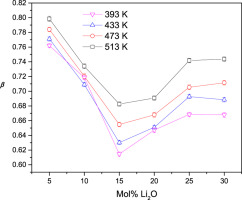当前位置:
X-MOL 学术
›
Solid State Sci.
›
论文详情
Our official English website, www.x-mol.net, welcomes your
feedback! (Note: you will need to create a separate account there.)
Thermal stability and ionic conduction characteristics of lithium germanate glasses
Solid State Sciences ( IF 3.4 ) Pub Date : 2020-03-01 , DOI: 10.1016/j.solidstatesciences.2019.106109 Prashant Dabas , R.C. da Silva , L.C. Alves , Márcia Vilarigues , T.S. Natarajan
Solid State Sciences ( IF 3.4 ) Pub Date : 2020-03-01 , DOI: 10.1016/j.solidstatesciences.2019.106109 Prashant Dabas , R.C. da Silva , L.C. Alves , Márcia Vilarigues , T.S. Natarajan

|
Abstract A report is given of the systematic investigation on the glass stability and conduction characteristics of binary lithium germanate glasses in the series, mol% xLi2O-(100-x)GeO2, 5 ≤ x ≤ 30. The glass stability (against devitrification) parameters along with density and glass transition temperature reveal an extremum around 15 mol% of Li2O, a signature of the germanate anomaly. The analysis of impedance data in conductivity and modulus formalisms reflect different aspects of the structural changes as the amount of Li2O increases. The lithium ion conductivity increases with the increase in the Li2O concentration while the activation energy for ionic motion does not change much from mol% 5 to 10 Li2O and decreases monotonically from mol% 10 to 30 Li2O indicating the absence of germanate anomaly. However, the data in modulus formalism does not scale to a master curve for all the glasses suggesting the germanate anomaly. Modeling of the modulus data using the Kohlrausch-Williams-Watts (KWW) function depicts the germanate anomaly in the stretched exponential parameter (β) at 15 mol% Li2O. Raman spectra of the glasses reveal the preferential formation of Q2 units at low alkali concentration along with the formation of ring structures of several Ge tetrahedra and/or the formation of higher coordinated Ge species around the anomalous composition region. A correlation of these structural changes with the conduction characteristics of the glasses is also discussed.
中文翻译:

锗酸锂玻璃的热稳定性和离子传导特性
摘要 系统研究了该系列二元锗酸锂玻璃的玻璃稳定性和导电特性,mol% xLi2O-(100-x)GeO2, 5 ≤ x ≤ 30。玻璃稳定性(抗失透)参数随着密度和玻璃化转变温度的变化,Li2O 的极值约为 15 mol%,这是锗酸盐异常的特征。对电导率和模量形式的阻抗数据的分析反映了随着 Li2O 量的增加,结构变化的不同方面。锂离子电导率随着 Li2O 浓度的增加而增加,而离子运动的活化能从 mol% 5 到 10 Li2O 变化不大,从 mol% 10 到 30 Li2O 单调降低,表明不存在锗酸盐异常。然而,模数形式中的数据没有按比例显示所有玻璃的主曲线,表明锗酸盐异常。使用 Kohlrausch-Williams-Watts (KWW) 函数对模量数据进行建模描绘了在 15 mol% Li2O 下拉伸指数参数 (β) 中的锗酸盐异常。玻璃的拉曼光谱揭示了在低碱浓度下优先形成 Q2 单元,同时形成几个 Ge 四面体的环结构和/或在异常组成区域周围形成更高配位的 Ge 物种。还讨论了这些结构变化与玻璃传导特性的相关性。使用 Kohlrausch-Williams-Watts (KWW) 函数对模量数据进行建模描绘了在 15 mol% Li2O 下拉伸指数参数 (β) 中的锗酸盐异常。玻璃的拉曼光谱揭示了在低碱浓度下优先形成 Q2 单元,同时形成几个 Ge 四面体的环结构和/或在异常组成区域周围形成更高配位的 Ge 物种。还讨论了这些结构变化与玻璃传导特性的相关性。使用 Kohlrausch-Williams-Watts (KWW) 函数对模量数据进行建模描绘了在 15 mol% Li2O 下拉伸指数参数 (β) 中的锗酸盐异常。玻璃的拉曼光谱揭示了在低碱浓度下优先形成 Q2 单元,同时形成几个 Ge 四面体的环结构和/或在异常组成区域周围形成更高配位的 Ge 物种。还讨论了这些结构变化与玻璃传导特性的相关性。玻璃的拉曼光谱揭示了在低碱浓度下优先形成 Q2 单元,同时形成几个 Ge 四面体的环结构和/或在异常组成区域周围形成更高配位的 Ge 物种。还讨论了这些结构变化与玻璃传导特性的相关性。玻璃的拉曼光谱揭示了在低碱浓度下优先形成 Q2 单元,同时形成几个 Ge 四面体的环结构和/或在异常组成区域周围形成更高配位的 Ge 物种。还讨论了这些结构变化与玻璃传导特性的相关性。
更新日期:2020-03-01
中文翻译:

锗酸锂玻璃的热稳定性和离子传导特性
摘要 系统研究了该系列二元锗酸锂玻璃的玻璃稳定性和导电特性,mol% xLi2O-(100-x)GeO2, 5 ≤ x ≤ 30。玻璃稳定性(抗失透)参数随着密度和玻璃化转变温度的变化,Li2O 的极值约为 15 mol%,这是锗酸盐异常的特征。对电导率和模量形式的阻抗数据的分析反映了随着 Li2O 量的增加,结构变化的不同方面。锂离子电导率随着 Li2O 浓度的增加而增加,而离子运动的活化能从 mol% 5 到 10 Li2O 变化不大,从 mol% 10 到 30 Li2O 单调降低,表明不存在锗酸盐异常。然而,模数形式中的数据没有按比例显示所有玻璃的主曲线,表明锗酸盐异常。使用 Kohlrausch-Williams-Watts (KWW) 函数对模量数据进行建模描绘了在 15 mol% Li2O 下拉伸指数参数 (β) 中的锗酸盐异常。玻璃的拉曼光谱揭示了在低碱浓度下优先形成 Q2 单元,同时形成几个 Ge 四面体的环结构和/或在异常组成区域周围形成更高配位的 Ge 物种。还讨论了这些结构变化与玻璃传导特性的相关性。使用 Kohlrausch-Williams-Watts (KWW) 函数对模量数据进行建模描绘了在 15 mol% Li2O 下拉伸指数参数 (β) 中的锗酸盐异常。玻璃的拉曼光谱揭示了在低碱浓度下优先形成 Q2 单元,同时形成几个 Ge 四面体的环结构和/或在异常组成区域周围形成更高配位的 Ge 物种。还讨论了这些结构变化与玻璃传导特性的相关性。使用 Kohlrausch-Williams-Watts (KWW) 函数对模量数据进行建模描绘了在 15 mol% Li2O 下拉伸指数参数 (β) 中的锗酸盐异常。玻璃的拉曼光谱揭示了在低碱浓度下优先形成 Q2 单元,同时形成几个 Ge 四面体的环结构和/或在异常组成区域周围形成更高配位的 Ge 物种。还讨论了这些结构变化与玻璃传导特性的相关性。玻璃的拉曼光谱揭示了在低碱浓度下优先形成 Q2 单元,同时形成几个 Ge 四面体的环结构和/或在异常组成区域周围形成更高配位的 Ge 物种。还讨论了这些结构变化与玻璃传导特性的相关性。玻璃的拉曼光谱揭示了在低碱浓度下优先形成 Q2 单元,同时形成几个 Ge 四面体的环结构和/或在异常组成区域周围形成更高配位的 Ge 物种。还讨论了这些结构变化与玻璃传导特性的相关性。











































 京公网安备 11010802027423号
京公网安备 11010802027423号